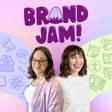
Ep. 2: Brain Dumps & Brainstorms: Finding Your Creative Flow
Join hosts Chloe and Darci as they give listeners a behind-the-scenes peek into the early stages of their own creative processes, sharing exactly how they turn jumbled thoughts into clearly executed ideas.
Breaking down the difference between a brain dump and a brainstorm, along with how to use each one, this episode’s conversation is packed with valuable advice for finding your creative flow when your brain feels busy or (worse!) blocked.
So, whether you’re sifting through endless ideas for your brand or struggling to get started, Brand Jam has your back!
Resources mentioned in this episode include:
Chloe & Darci’s favorite free graphic design tool > Canva
Darci’s favorite pens > Pilot G2 in .38
Chloe’s favorite pens > Pilot G2 in .5
Creative coach extraordinaire > Caitlin Liz Fisher
Follow Brand Jam:
Instagram https://www.instagram.com/brandjampod/
Threads https://www.threads.net/@brandjampod
Website https://www.brandjampod.com
Follow Chloe at Chloe Arielle Design:
Website https://www.chloearielle.com/
Instagram https://www.instagram.com/chloearielle
Threads https://www.threads.net/@chloearielle
Follow Darci at Sweet Tooth Creative
Website https://sweettoothcreative.com/
